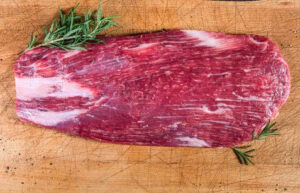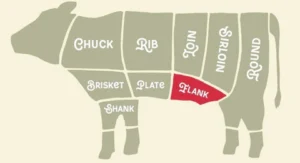
Where does Flank steak come from?
The flank steak typically comes from the abdominal muscle right under the lower chest. It is part of the underbelly, which is a very hardworking area of the body and tends to develop muscular strength.

What’s in a name?
Other names for flank steak include flank steak filet or jiffy steak.
But how do I cook it?
When it comes to cooking your Flank steak, there are just a few important factors to remember!
Like the more common cuts of beef, it should be cooked until the internal temperature reaches 145 °F whether you’re grilling, pan-cooking, or roasting in your oven.
Once cooking is done, do not forget to let the steak rest for approximately 10-15 minutes before cutting. This allows the juices to redistribute throughout the steak.
It’s easy to ruin flank steak because the meat is so lean. If it’s grilled too far past medium-rare, it will toughen to the consistency of shoe leather. One exception: If the meat is braised at a low temperature, the meat should remain tender.
Flank steak should be thinly sliced against the grain. Slicing it with the grain will make it difficult to chew.
But how do I cut it?
Using a sharp knife, you will then need to cut against the grain. Doing so will leave the meat more tender. The “grain” is a term that is used to identify the direction in which the muscle fibers of the meat lie. Typically, you will be making your cuts widthwise rather than lengthwise.
How you serve your steak will depend on how you like it. Flank steak is best served rare or medium-rare and sliced into thin pieces for a tender and juicy result.
If you’re not trying the lesser-known cuts of meat you’re seriously missing out. By branching out and trying other cuts of meat, you’re blessed with the best of both worlds. Not only are you greeted with a more affordable price, but you’re also treated to unbelievable flavors.
The story of the Flank is the same as the Roseda story – you have to taste it to believe it!